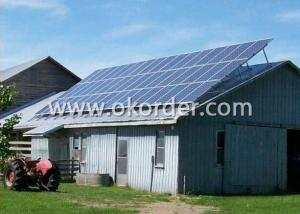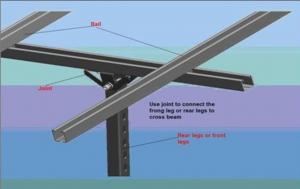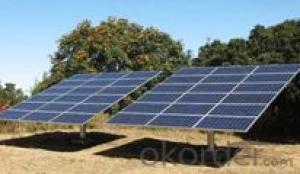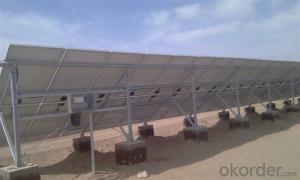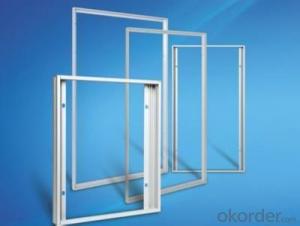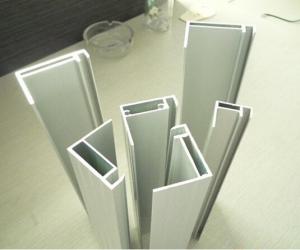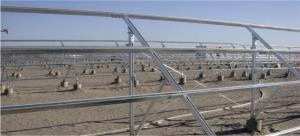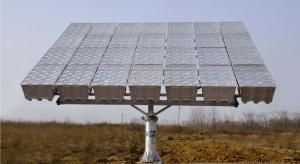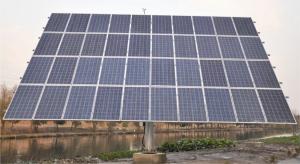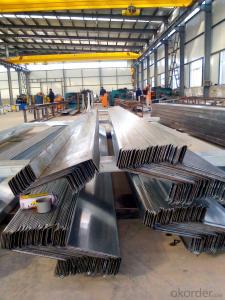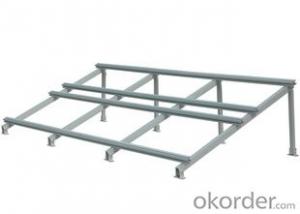Solar Panel Monting System TT-EC-F50
- Loading Port:
- China Main Port
- Payment Terms:
- TT OR LC
- Min Order Qty:
- -
- Supply Capability:
- -
OKorder Service Pledge
OKorder Financial Service
You Might Also Like
PV Mounting brackets are special solar photovoltaic systemfor placing, installing, fixing the solar panel design. Generally materials arealuminum, steel structure, stainless steel. PV mounting products at groundmounting system, flat roof mounting system, adjustable angle roof rack system,inclined roof rack system, column bracket system.
The Ground Mounting System including concret basement sysytemand steel pipe sysytem, Titanergy provides total solution for flat or pitchedroof with patent products.On the basis of the given project data, specificnational standards and guidelines, Titanergy will calculate the completestructural analysis and create a complete project plan to make sure reliablestructural safety.We provide high quality HDG steel and aluminum products forthe ground mounting sysytem,witch can make sure the security and durability ofthe project.
Features and Advantages
n The rail bracket is easy to install, just use simple tools(eg, Allen wrench) can be easily installed. Rail connecting member can freelyadjust the length, the stent may be pre-installed on the roof, and thenappropriately adjusted according to the size of the solar panel.
n The combination of strong, aluminum rails and card blocks fora variety of venues and a variety of materials roofs (such as metal, ceramicand other kinds of tile surface)
n Component compatibility, and rail can meet PV modules fromdifferent manufacturers.
n accuracy, the length of the rail to the nearest millimeter,the construction process, not because of the length is too long or too shortfor the second cut.
n flexible assembly, rail hooks can adjust the spacing modulearray and tile has been installed successfully address the uneven roofconstruction led to difficult problems.
n design standards, product design and development process instrict accordance with GB, the German standards and other internationalstandards to ensure products reach the world advanced level.
n Quality assurance, the stent main material is high-qualityaluminum and stainless steel, effectively prevent corrosion of oxidation.Products can be recycled, reducing environmental pollution.
n Carried out strictly according to the current specificnational standards
n Perfectly optimized components and complete structuralanalysis for the sysytem
n High corrosion resisitance ensure the stability and highdurability
n Total test and certification make sure the high quality ofthe products
n Maximum pre-assembled in factory,quick mounting onsite,timesaving
10-year durability warranty
Technical Data
n Design Period:25 years
n Installation Site: Open area
n Array Angle:10°~60°
n ModuleType:Framed or unframed
n Material:Q235B,Al 6063-T5,Al 6005-T5,StainlessSteel A2-70
n Coating:HDG/Anodised
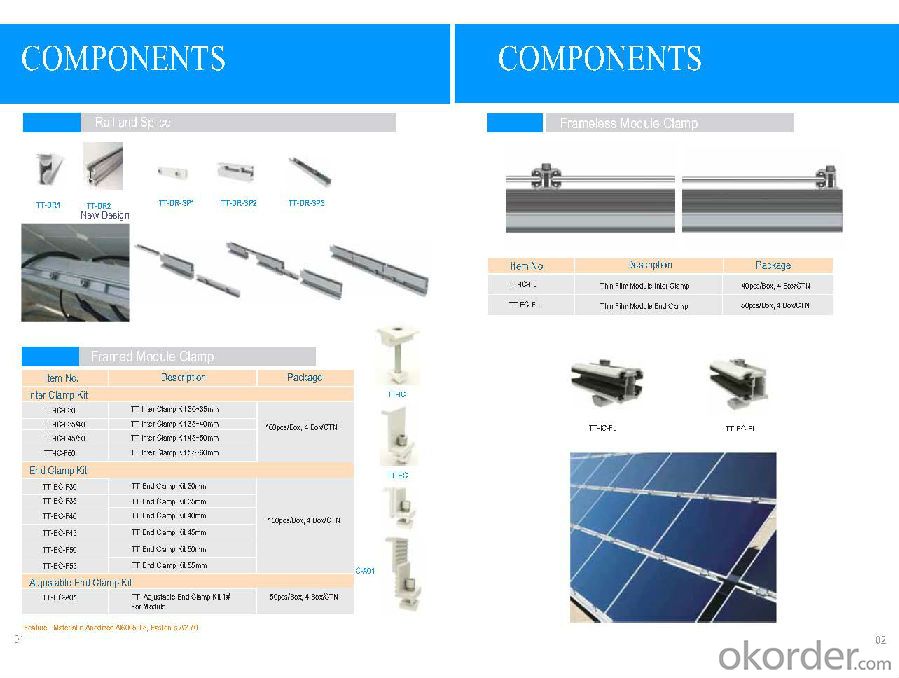

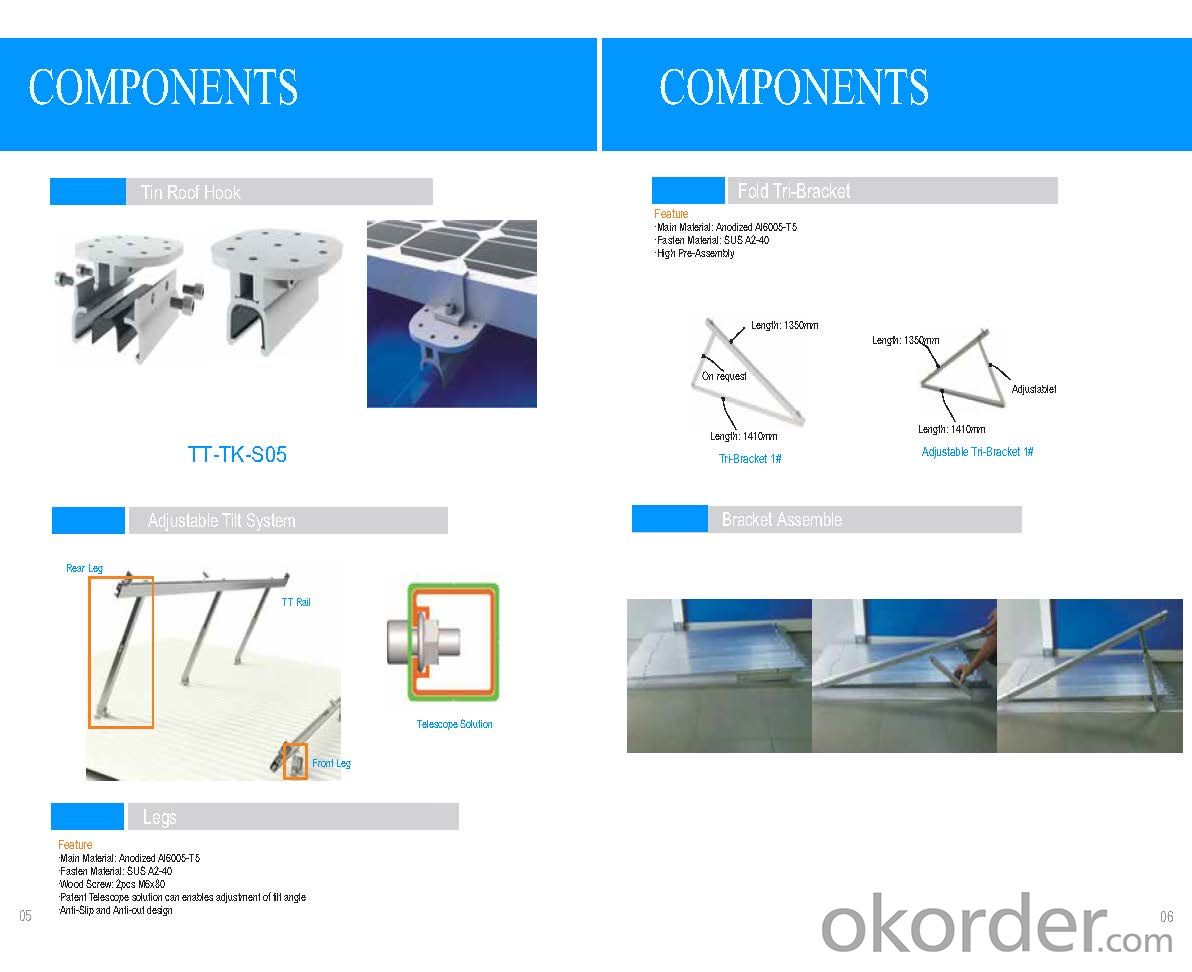
- Q:How does shading affect the performance of a solar mounting system?
- Shading can significantly impact the performance of a solar mounting system as it obstructs the direct sunlight reaching the solar panels. Shading reduces the overall energy output of the system, resulting in lower efficiency and decreased power generation. Therefore, it is crucial to minimize shading by properly designing the mounting system, considering the orientation, tilt angle, and surrounding objects such as trees or buildings to maximize sunlight exposure and optimize performance.
- Q:Are there any specific requirements for installing a solar mounting system on a rooftop with rooftop HVAC ducts?
- Yes, there are specific requirements for installing a solar mounting system on a rooftop with rooftop HVAC ducts. It is important to ensure that the solar panels do not obstruct or interfere with the HVAC ducts, as this can affect the performance and efficiency of the HVAC system. Additionally, proper clearance and spacing must be maintained between the solar panels and the ducts to allow for proper airflow and ventilation. It is recommended to consult with a professional solar installer who can assess the specific situation and provide guidance on the best installation approach to accommodate the rooftop HVAC ducts.
- Q:Are there any specific requirements for the solar panels to be used with a solar mounting system?
- Yes, there are specific requirements for the solar panels to be used with a solar mounting system. The solar panels need to be compatible with the mounting system in terms of size, weight, and design. They should have appropriate mounting holes or brackets that align with the mounting system. Additionally, the panels should have the necessary electrical specifications that are compatible with the system, such as voltage and current ratings.
- Q:Can a solar mounting system be used in areas with solar incentives for parking lots?
- Yes, a solar mounting system can be used in areas with solar incentives for parking lots. In fact, it is an ideal solution as it allows for the installation of solar panels on parking lot structures, maximizing the use of available space and generating clean energy while taking advantage of the incentives provided by the local government or utility companies.
- Q:What is the expected energy payback time for a solar mounting system?
- The expected energy payback time for a solar mounting system varies depending on various factors such as the type and efficiency of the solar panels, the location and amount of sunlight received, and the system's design. On average, however, it typically ranges from 1 to 4 years.
- Q:Can a solar mounting system be installed on a ground surface?
- Yes, a solar mounting system can be installed on a ground surface. Ground-mounted solar systems are commonly used in locations where roof space is limited or unsuitable for solar panel installation. Ground mounting allows for optimal positioning and orientation of the solar panels to maximize sunlight exposure.
- Q:Are there any specific requirements for battery placement when using a solar mounting system?
- Yes, there are specific requirements for battery placement when using a solar mounting system. The batteries should be placed in a well-ventilated area to prevent overheating and should be kept away from direct sunlight or extreme temperature fluctuations. They should also be easily accessible for maintenance and inspection purposes. Additionally, the battery placement should comply with the manufacturer's guidelines and local codes or regulations.
- Q:What is the expected maintenance cost over the lifetime of a solar mounting system?
- The expected maintenance cost over the lifetime of a solar mounting system can vary depending on various factors such as the quality of the system, its design, the environmental conditions it is exposed to, and the level of maintenance performed. However, on average, the maintenance cost for a solar mounting system is relatively low. It typically involves periodic inspections, cleaning of solar panels, and potential repairs or replacements of components due to wear and tear. Overall, the maintenance cost is relatively minimal compared to the long-term energy and cost savings that solar systems provide.
- Q:Are there any specific requirements for installing a solar mounting system on the ground?
- Yes, there are specific requirements for installing a solar mounting system on the ground. Some of the key requirements include a suitable location with sufficient space and unobstructed access to sunlight, a stable and level ground surface, proper soil conditions for anchoring the mounting system, compliance with local building codes and regulations, and consideration of any potential shading issues. Additionally, factors like wind speed, snow load, and seismic activity may also influence the design and installation of the mounting system.
- Q:Can a solar mounting system be installed in a high-wind or hurricane-prone area?
- Yes, a solar mounting system can be installed in a high-wind or hurricane-prone area. However, it is crucial to use specifically designed and tested mounting systems that are capable of withstanding high winds and extreme weather conditions. These specialized systems employ advanced engineering techniques, such as reinforced foundations, robust brackets, and secure fastening methods, to ensure the solar panels remain securely in place during strong winds or hurricanes. Additionally, local building codes and regulations should be followed to guarantee the installation meets the necessary safety standards for high-wind areas.
1. Manufacturer Overview |
|
|---|---|
| Location | |
| Year Established | |
| Annual Output Value | |
| Main Markets | |
| Company Certifications | |
2. Manufacturer Certificates |
|
|---|---|
| a) Certification Name | |
| Range | |
| Reference | |
| Validity Period | |
3. Manufacturer Capability |
|
|---|---|
| a)Trade Capacity | |
| Nearest Port | |
| Export Percentage | |
| No.of Employees in Trade Department | |
| Language Spoken: | |
| b)Factory Information | |
| Factory Size: | |
| No. of Production Lines | |
| Contract Manufacturing | |
| Product Price Range | |
Send your message to us
Solar Panel Monting System TT-EC-F50
- Loading Port:
- China Main Port
- Payment Terms:
- TT OR LC
- Min Order Qty:
- -
- Supply Capability:
- -
OKorder Service Pledge
OKorder Financial Service
Similar products
New products
Hot products
Related keywords


